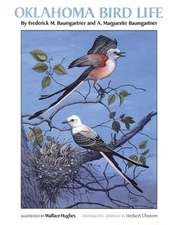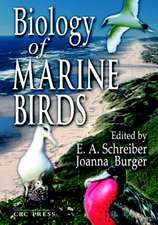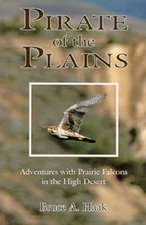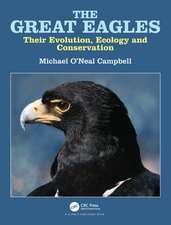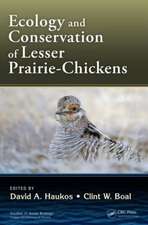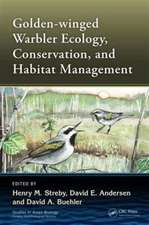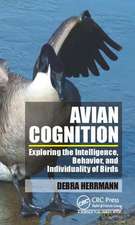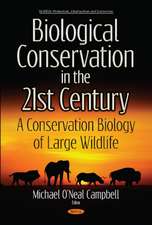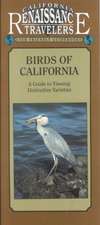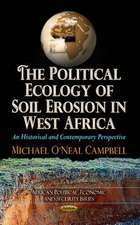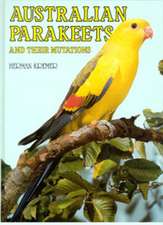Vultures: Their Evolution, Ecology and Conservation
Autor Michael O'Neal Campbellen Limba Engleză Hardback – 26 iun 2015
Conservation questions concern the extent to which recent land cover change (deforestation, urbanization, and desertification), wildlife depletions, and pollution have affected scavenging vultures. Such changes are examined as both positive and negative for vultures—a growing body of literature hints at the positive impacts of urban waste, more open forests, forest fires, landscape cultivation, road kills, and shore development, especially with increased attention to bird adaptation and "new" theories of adaptive management in conservation. These are contrasted with the conservation of other raptors and scavengers. Within new trends in conservation, with emphases on animal/human shared co-evolution in intensely habituated spaces, vulture conservation requires important new perspectives that contrast with the needs of other species conservation.
| Toate formatele și edițiile | Preț | Express |
|---|---|---|
| Paperback (1) | 360.10 lei 3-5 săpt. | +35.21 lei 5-11 zile |
| CRC Press – 18 dec 2020 | 360.10 lei 3-5 săpt. | +35.21 lei 5-11 zile |
| Hardback (1) | 771.54 lei 6-8 săpt. | |
| CRC Press – 26 iun 2015 | 771.54 lei 6-8 săpt. |
Preț: 771.54 lei
Preț vechi: 1031.73 lei
-25% Nou
Puncte Express: 1157
Preț estimativ în valută:
147.65€ • 153.58$ • 121.90£
147.65€ • 153.58$ • 121.90£
Carte tipărită la comandă
Livrare economică 14-28 aprilie
Preluare comenzi: 021 569.72.76
Specificații
ISBN-13: 9781482223613
ISBN-10: 1482223619
Pagini: 374
Ilustrații: 9 black & white illustrations, 23 colour illustrations
Dimensiuni: 156 x 234 x 25 mm
Greutate: 0.86 kg
Ediția:1
Editura: CRC Press
Colecția CRC Press
Locul publicării:Boca Raton, United States
ISBN-10: 1482223619
Pagini: 374
Ilustrații: 9 black & white illustrations, 23 colour illustrations
Dimensiuni: 156 x 234 x 25 mm
Greutate: 0.86 kg
Ediția:1
Editura: CRC Press
Colecția CRC Press
Locul publicării:Boca Raton, United States
Cuprins
Systematic List of Old World Vultures: The Griffons. Systematic List of Old World Vultures: Huge and Small Non-Griffons. Systematic List of New World Vultures. The Biological Evolution of Vultures. Vultures, Facultative Scavengers and Predators. Climate, Landscapes and Vultures. Vultures, Cultural Landscapes and Environmental Change. Vultures, Chemicals and Diseases. Vultures in Social History and Conservation. The Future of Vultures: Conclusions and Summary
Recenzii
"This book provides an accessible and well-referenced review of our current knowledge of vultures."
—Blaise Martay, BTO News
"This authoritative volume provides detailed information on all vultures of the world, including condors. Campbell's thorough review of the literature is reflected in the 188-page bibliography (some 3,700 references, cited throughout). Summing Up: Highly recommended."
—H. T. Armistead, Free Library of Philadelphia, in CHOICE
"Any college-level collection strong in specific wildlife topics will find this a unique and solid reference acquisition."
—California Bookwatch
—Blaise Martay, BTO News
"This authoritative volume provides detailed information on all vultures of the world, including condors. Campbell's thorough review of the literature is reflected in the 188-page bibliography (some 3,700 references, cited throughout). Summing Up: Highly recommended."
—H. T. Armistead, Free Library of Philadelphia, in CHOICE
"Any college-level collection strong in specific wildlife topics will find this a unique and solid reference acquisition."
—California Bookwatch
Descriere
This book examines current knowledge on the evolution, ecology, and conservation biology of both New World vultures (Cathartidae) and Old World vultures (Accipitridae). Extinct species of both families are examined, as well as the disputed evidence for familial similarities and differences currently under review by geneticists and ornithologists. The book also discusses conservation issues related to recent land cover change (deforestation, urbanization, and desertification), wildlife depletions, and pollution, which affect scavenging vultures.



